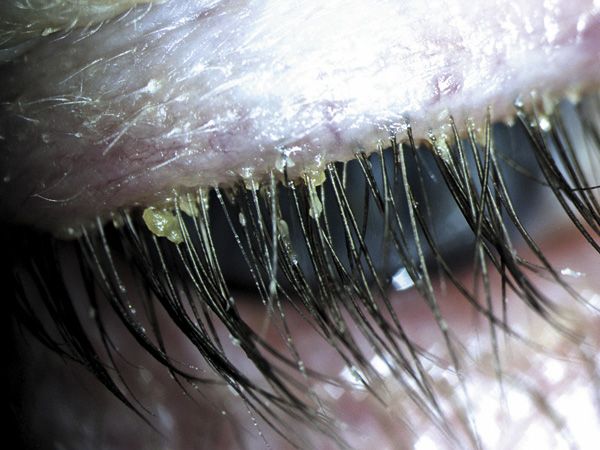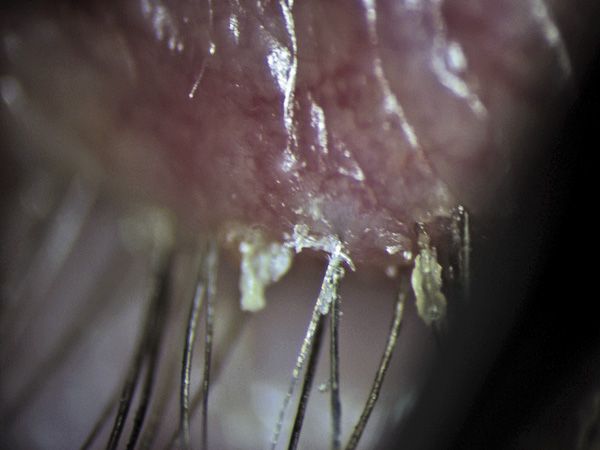It might be mites
Abundant populations of Demodex mites may exacerbate coexisting lid-margin disease.
Although most clinicians think of the Demodex mite as a harmless, ubiquitous resident of the skin, growing opinion suggests that Demodex can be pathogenic. It is thought Demodex overpopulation (demodicidosis) is responsible for various skin disorders such as rosacea,1 perioral dermatitis,2,3 and blepharitis.4-7 Interestingly, the association between Demodex and both acne vulgaris and blepharitis is statistically significant.

Dr. MastrotaAbundant Demodex populations may exacerbate coexisting lid-margin disease. Demodex infestation is an often-overlooked differential diagnosis in the clinical investigation of blepharitis and may be a cause of treatment failure when not specifically targeted.
Mites double-team the eyes
Two species of Demodex mites have been identified in humans: Demodex folliculorum and Demodex brevis. In the eyelids, Demodex folliculorum can be found in the lash follicle, while Demodex brevis burrows deep into sebaceous and meibomian glands. It has been proposed that mites feed on follicular and glandular epithelial cells, leading to direct damage of the lid margin. Demodex overpopulation is associated with trichiasis and eyelash disorganization, madarosis,8 meibomian gland dysfunction, conjunctival inflammation, and corneal pathology.9 Also, infestation of Demodex mites induces a change of tear cytokine levels, especially interleukin 17, also called IL-17, which can cause inflammation of the lid margin and ocular surface.10,11

Figure 1. Demodex infestation can lead to direct damage of the lid margin.In 1967, Coston described the anatomy and physiology of the Demodex folliculorum mite and its related blepharitis.12 Coston used a light microscope to examine Demodex that were attached to epilated eyelashes. Subsequent studies identified cylindrical dandruff surrounding the base of eyelashes, thought to be an accumulation of Demodex excreta and other debris (keratins and lipids13), as pathognomonic for ocular Demodex infestation.14 Lashes are now selected for epilation/examination based on this finding. Hom et al15 described a clinical sequence for the identification of Demodex, which includes a clinical history of blepharitis, dry eyes, or ocular allergy; slit lamp examination of cylindrical dandruff; and confirmation using a light microscope evaluation of epilated lashes.
Recently, I began offering a technique to identify Demodex in the eyelash follicle by eyelash rotation, which may be used as an alternative to lash epilation. Rotating the eyelash can churn up and make visible mites in eyelash follicles that may not exhibit cylindrical cuffing.16

Figure 2. Demodex rotation. (Photos courtesy Scott G. Hauswirth, OD, FAAO)Reining in the mite population
To date, a standard treatment protocol has not been accepted. However, a number of methods have been proposed for controlling Demodex folliculorum populations on the lid margins. Gao determined that tea tree oil is acaracidal in a dose-dependent fashion.17 Practitioner-formulated tea tree oil solutions/ointments, commercially made tea tree oil preparations, or eyelash cleaners with acaracidal activity are now favored to address Demodex blepharitis. Most treatment strategies follow the protocol described by Gao17 and involve a weekly in-office treatment of 50% tea tree oil solution, applied in two to three 10-minute intervals, followed by lid hygiene at home with a 10% tea tree oil solution over 1 month. Recently, Koo et al documented frequent tea tree oil scrubs as an effective method for eliminating Demodex when applied as described.18
The first step in treating demodicidosis is recognizing it.
Suspicion of the mite, generated by patient signs and symptoms-including chronic blepharitis, conjunctival or corneal inflammation, eye or eyelid itching-a greasy or oily-looking lid margin, or the presence of cuff dandruff/cylindrical casts, volcanic-like thickening around the base of the eyelash contiguous with the skin (compacted mite tails or debris) should lead the examiner to perform eyelash epilation/rotation to access the presence of mites.
Watch Optometry Times for an upcoming in-depth look at combating Demodex, including practice management recommendations from Mario Gutierrez, OD.ODT
References
Zhao Y, Peng Y, Wang XI, Wu L, et al. Facial dermatosis associated with Demodex: a case-control study. J Zhejiang Univ Sci. 2011;12(12):1008–1015.
Hsu CK, Hsu MM, Lee JY. Demodicosis: a clinicopathological study. J Am Acad Dermatol. 2009;60(3):453-462.
Ting PT, Barankin B. Answer: Can you identify this condition? Melasma. Can Fam Physician. 2005 Mar;51(3):353-355.
Liang L, Safran S, Gao Y, Sheha H, et al. Ocular demodicosis as a potential cause of pediatric blepharoconjunctivitis. Cornea. 2010;29(12):1386-1391.
Liu J, Sheha H, Tseng SC. Pathogenic role of Demodex mites in blepharitis. Curr Opin Allergy Clin Immunol. 2010;10(5):505-510.
Czepita D, Kuźna-Grygiel W, Czepita M, Grobelny A. Demodex folliculorum and Demodex brevis as a cause of chronic marginal blepharitis. Ann Acad Med Stetin. 2007; 53(1):63-67.
Liu J, Sheha H, Tseng SC. Pathogenic role of Demodex mites in blepharitis. Curr Opin Allergy Clin Immunol. 2010;10(5):505–510.
Kumar A, Karthikeyan K. Madarosis: A marker of many maladies. Int J Trichology. 2012;4(1):3–18.
Kheirkhah A, Casas V, Li W, Raju VK, Tseng SC. Corneal manifestations of ocular demodex infestation. Am J Ophthalmol. 2007;143(5):743-749.
Kim JH, Chun YS, Kim JC. Clinical and immunological responses in ocular demodecosis. J Korean Med Sci. 2011;26(9):1231-1237.
Kim JT, Lee SH, Chun YS, Kim JC. Tear cytokines and chemokines in patients with Demodex blepharitis. Cytokine. 2011;53(1):94-99.
Coston T. Demodex folliculorum blepharitis. Trans Am Ophthalmol Soc. 1967; 65:(2)361–392.
English FP. Demodex folliculorum and oedema of the eyelash. Br J Ophthalmol. 1971;55:(11 )742-746.
Gao Y, DiPascuale MA, Li W, et al. High prevalence of Demodex in eyelashes with cylindrical dandruff. Invest Ophthalmol Vis Sci 2005;46:(9)3089-3094.
Hom MM, Mastrota KM, Schachter SE. Demodex. Optom Vis Sci. 2013;90(7):e198-205.
Mastrota KM. Method to identify Demodex in the eyelash follicle without epilation. Optom Vis Sci. 2013;90(6):e172-174.
Gao YY, Di Pascuale MA, Li W, Baradaran-Rafii A, et al. In vitro and in vivo killing of ocular Demodex by tea tree oil. Br J Ophthalmol. 2005;89(11):1468-1473.
Koo H, Kim TH, Kim KW, Wee SW, Chun YS, Kim JC. Ocular surface discomfort and Demodex: effect of tea tree oil eyelid scrub in Demodex blepharitis. J Korean Med Sci. 2012;27(12):1574-9.